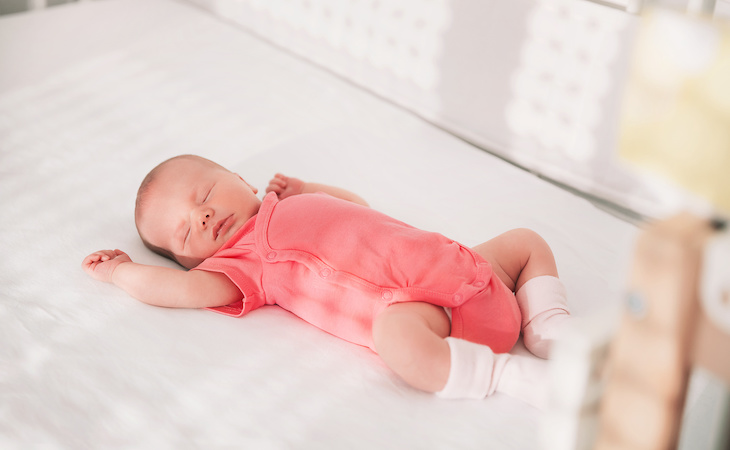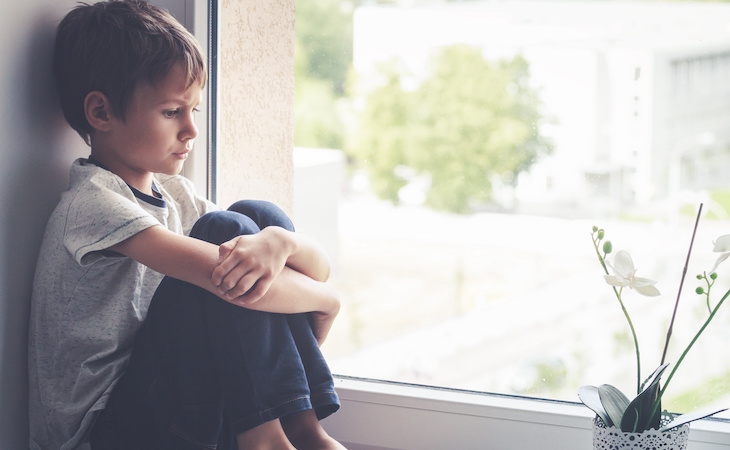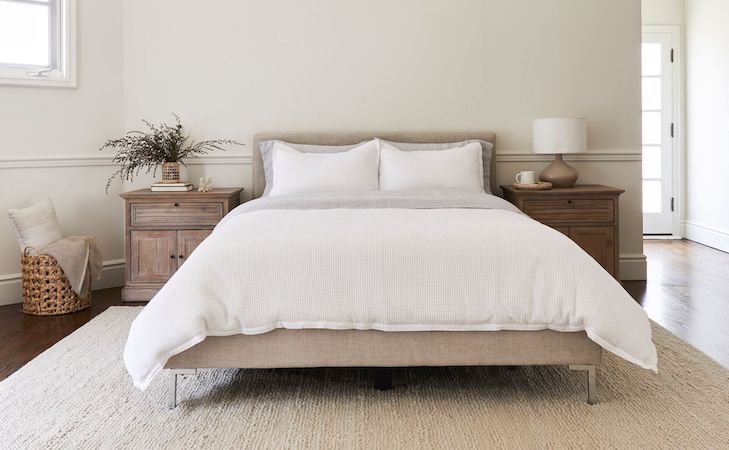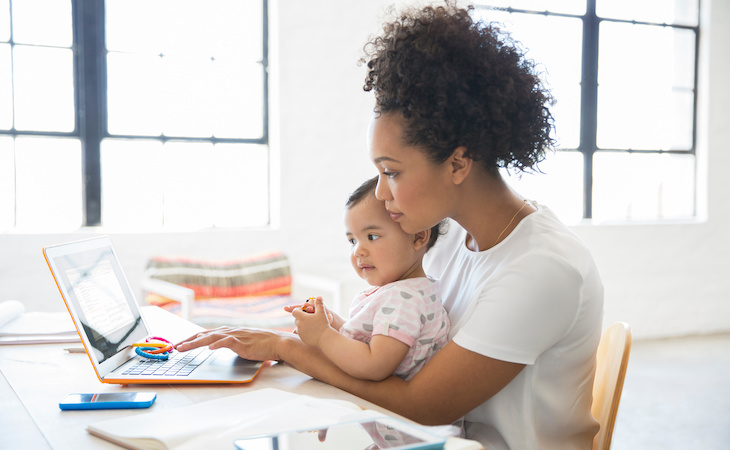Every parent longs for more restful, uninterrupted sleep at night, causing many to try every new baby product out there that touts longer stretches of snooze time. Weighted sleep sacks are the latest “it” products that claim to relax your baby’s nervous system so they’re able to fall—and stay—asleep faster and longer.
But because these weighted sleep sacks have a little more heft to them than the conventional sleep sack, should you worry about your baby’s safety while wearing them? Ahead, we break down what weighted sleep sacks are and what research says about them and ask pediatricians to weigh in on their risks.
What is a weighted sleep sack?
Unlike a swaddle, a sleep sack is worn like a piece of clothing that zips up; it keeps your baby’s arms free while covering their torso, legs, and feet like a blanket. When your baby has outgrown swaddling and can roll over on their own, you can opt to use a sleep sack, which allows them to move more freely. Although sleep sacks are safe for sleep for babies, weighted sleep sacks are a different story.
Similar to weighted blankets for adults, weighted sleep sacks are built with a special technology that evenly distributes weight in the sack. But some brands add extra weight to certain areas of the body, where you tend to hold and touch your baby.
The idea is that the light and gentle pressure helps your baby feel safe and calm as if you were hugging them through the night. This helps encourage relaxation and sleep. Most weighted sleep sack brands require babies to reach a certain weight—anywhere from 7-8 pounds for newborns to 6 months—in order to wear them.
However, research on the safety and effectiveness of weighted sleep sacks is limited, so it’s difficult to say whether they actually help promote better sleep. Most related studies have been done only on a very small subset of infants or children—and the products used in these studies are variations of a weighted blanket (which aren’t safe for babies and toddlers)—instead of a sleep sack.
For example, a small 2020 study in Advances in Neonatal Care, which included 16 infants with neonatal abstinence syndrome, found that the use of weighted blankets reduced the infants’ heart rates without affecting their breathing. That said, this study was tested only on a very small group of infants specifically diagnosed with neonatal abstinence syndrome, a condition that happens when babies have had extended exposure to opioid drugs in the womb, per the National Library of Medicine.
Another small 2021 study in the International Journal of Environmental Research and Public Health showed that sleeping with weighted blankets improved sleep and overall well-being in children with attention deficit hyperactivity disorder (ADHD) and sleep issues. But the children in this study were much older, between the ages of 6 and 15, and the weight of the blankets was customized to each child’s height, weight, age, sex, the degree of their sleep issues, and their subtype of ADHD.
Are weighted sleep sacks safe for babies?
The short answer is no. “The American Academy of Pediatrics (AAP) in 2022 revised its sleep recommendations and included in the statement that weighted blankets are not considered safe for babies,” says Elena Shea, MD, a pediatrician and board-certified lactation consultant. According to the AAP’s statement, any form of weighted bedding, including blankets, swaddles, and sleepers, placed on or near a sleeping infant isn’t recommended.
“The sacks can lead to overheating, which is a known risk of sudden infant death syndrome (SIDS),” says Shea. “Also, there is a concern that if a baby rolls, they may not be able to roll back, which can lead to suffocation.”
But once your baby is able to roll on their own, is it safe to place them in a weighted sleep sack? Not quite. Although the AAP doesn’t have an official statement on whether weighted sleep sacks or blankets are safe for older children, you should generally avoid them for toddlers under the age of 2, says Ashanti Woods, MD, a pediatrician at Mercy Medical Center.
“The muscles of an infant’s chest, even those of toddler ages 1 or 2, are still developing,” explains Woods. “We don’t want to restrict a young child’s breathing. But usually, by the time a child is 2, the muscles of the chest are more developed—not fully developed—but they may be more developed to sustain the weight of your general weighted sleep sack.” That said, he advises against using them altogether because their safety hasn’t been well-studied.
More diverse studies and research is needed on weighted sleep sacks and their effectiveness and safety in order for the AAP to recommend them. So until then, you’d be hard-pressed to find a pediatrician who will endorse using them, even ones that claim to use a very light amount of weight.
“For right now, we have to say that we’re not sure whether they are safe or not,” says Woods. “It could be unsafe, so for a pediatrician to recommend something, we want to be sure that it’s safe.”
In the meantime, you should also exercise caution when using weighted blankets for older children. That’s because there can be an increased risk of suffocation and circulation concerns, notes Shea.
“Weighted blankets are typically too heavy for young children to move freely,” she says. “Remember for adults, a weighted blanket should not be more than 10% of body weight or it can cause overheating and suffocation.”
Other ways to help babies sleep
Fortunately, there are plenty of other safer and more proven ways to help your baby sleep. For example, ensuring your baby is well-fed before they go to bed (meaning they’re having a full feeding) will help them sleep longer, says Woods.
Babies who are less than a month old may consume 3-4 ounces of breast milk or formula per feeding every three to four hours, according to the AAP. So it’s natural for young babies to wake up frequently in the middle of the night for a feeding.
Swaddling can also help. It gives babies a similar feeling of being inside the womb, may help reduce their anxiety and calm them down, and helps restrict their movement so they stay asleep.
When you swaddle your baby, make sure to place them on their back. As soon as your baby starts to roll on their own, discontinue swaddling and transition to a sleep sack. Your baby should always sleep alone in their crib or bassinet, meaning there are no stuffed animals, blankets, or other soft bedding, Woods says.
If you give your baby a middle-of-the-night feeding, try to speak softly and avoid doing anything that will wake them up completely, according to the AAP. During the day, maintain your baby’s nap schedule and look out for sleepy cues. Putting them down when they’re sleepy ensures that they aren’t overtired, which can make it more difficult for them to fall and stay asleep.
Getting your baby into a bedtime routine early on can also help with sleep training them. For example, you can start the bedtime routine with a warm and relaxing bath, followed by a few books, and then a feeding before bed.
FAQs
Do weighted sleep sacks work?
There isn’t enough research to support the idea that weighted sleep sacks can help babies feel more relaxed, and therefore, elongate their sleep. The AAP strongly advises parents to avoid using any weighted sleep products, including swaddles, blankets, and sleep sacks, due to their suffocation risk.
What age is a weighted sleep sack for?
If you would like your baby to try a weighted sleep sack, Woods recommends waiting until your toddler is at least 2 years old. At this age, it’s likely your child’s chest muscles are more fully developed and they’re more mobile and able to move on their own. However, weighted sleep sacks aren’t advised in general because there is little research to back their safety. That said, if you opt for a weighted sleep sack, make sure to follow the size guides carefully as many have weight requirements.
Can your baby sleep with a pacifier? We put together a guide to whether it’s safe for a baby to sleep with a pacifier.




